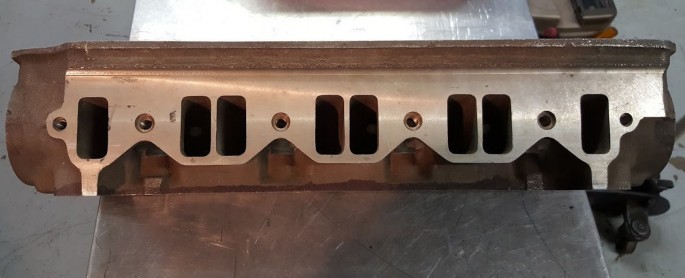When Chrysler took first, second and third at the 1964 Daytona 500, two things happened: it immediately put Bill France on high alert, and it gave the competition…namely, Ford, since GM wasn’t wanting to play anymore…all the reason to go into the engineering department with a battle mentality. Chrysler had stomped the Fords into the ground and president Lynn Townshend was hell-bent to keep his position on the top. Ford wasn’t having any of it and soon rumors started to fly about a overhead-cam 427 Ford being tested. While Ford was trying to get France to approve the use of their engine, the Chrysler camp was hearing about the new bullet coming from Dearborn…and they were not happy in the least. Knowing that Ford was going all-in, Chrysler decided to do the same…but just a touch more radical, to make sure that they had one final nail for the coffin. Known internally as the “A-925 Project”, the plan was simple and similar to what Ford was doing: The base 426 Race Hemi block would be used, but from the heads up, things were going to be a lot different. The heads themselves would be a four-valve DOHC design, with a Gilmer cog belt driving the four cams via two rollers and a geared axle system under the valve covers, a much more elegant solution than the 427 Cammer’s gigantic timing chain. The intake manifold was an eight-runner magnesium piece meant for a single four-barrel…this was going to be a NASCAR engine first and foremost. Projections for the A-925 Hemi setup were staggering: with valve train shrunken down to a bare minimum, Chrysler engineers were expecting a 7,000 RPM redline, though there was potential for 10,000 RPM or more on the table. Unfortunately, it was never to come to fruition: The one A-925 Hemi that was completed was never fired…problems with the tappet carriers during static testing, and before Chrysler was able to fix the problem, NASCAR stepped in and put a full stop to what it saw as high-dollar, low-production engines that were threatening the “down home” image of the racing series. Both A-925 and the 427 Cammer were outright banned, as well as the regular Race Hemi for the 1965 season.
Which leads us to this eBay listing, for one A-925 Hemi head. If you think that this is simply a fake casting, research shows that might not be the case: after the program was closed down, it seems that Chrysler sold off the parts as a way to recoup more than scrap value for the parts…and that includes the one complete A-925 Hemi. The head itself is bare and unfinished, but with the advances of technology, how hard would it be for a competent shop to take one head, make a second, and get to work on making the missing pieces? The heads themselves are meant to bolt directly onto a 426, so it isn’t exactly one-off territory. Need we say it again? 10,000 RPM DOHC 32-valve Chrysler Hemi. The possibilities are endless…





























I remember reading in Hot Rod Magazine way way back about a guy that owned a complete A-925 Hemi engine. The article showed the engine on a stand and its intended “transplant” vehicle in the background, a 1965 Dodge Coronet I want to believe.
What has ever happened to that engine and that guy? Is there a car running this engine lurking out there? This article was easily over 25-30 years ago.
I too remember that issue of Hot Rod magazine, must have been around the early 1980’s. I doubt that engine would have ever been parted out, so I’m a little skeptical of this single head.
Even if they only assembled one, they may have made a couple more castings. As this one doesn’t seem to have had its machining finished, it probably wasn’t put on the assembled motor.
Head looks like it bolts to a 440 block, not the Hemi-type, going by the fastener position between the intake ports. Neat piece, them ‘ol Chryslers could’ve easily fit OHC’s under the hood.
How do you bridge the gap between old-school cool and a modern mill? DOHC 32 valve 440 Six Pack! Heads would explode…
I remember reading an interview with a Dodge engineer who said that the A925 was never even intended to run. It was just built as a mockup to make NASCAR flinch and ban the Ford SOHC 427.
A timing belt? With ’60s rubber technology?Good luck with that! Sorry, but I see major fail there. Ford’s 427 SOHC timing chain may have been massive but at least it was stout.
The Pontiac OHC-6 used a rubber timing belt and never had an issue. And Ford had serious issues with their timing a chain, a big part of why that engine never really saw any success in drag-racing, comparatively.
My God…its come back-from-the -dead! Its the Doomsday Hemi.
I had read several years ago, that they had 1 assembled motor and parts to assemble 2 more.. All had been purchased by one individual in I thought Australia. That was being developed to take down the OHC Fords. The basic motor was supposed to start at 600 HP in street trim.. and go up fast from there. I would love to see someone start remaking the castings. There should certainly be enough technology available now to make these available and affordable.
At one time there was what looked to be a complete engine in the now closed Chrysler Museum in suburban Detroit.
A curiosity for sure. Useless, but a nice conversation piece. I’d give $100 for it, $10,000 is absolutely insane. I hope the guy didn’t pay more than $50 for it.
Oldsmobile played around with SOHC 16- and 32-valve hemi 455s a few years later, and even made an aluminum version with an eye toward running it in Can-Am. Sadly none of them ever made it past the prototype stage.